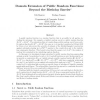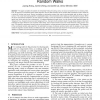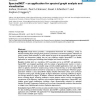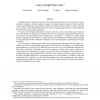125 search results - page 17 / 25 » Growth of components in random graphs |
CRYPTO
2007
Springer
14 years 1 months ago
2007
Springer
A public random function is a random function that is accessible by all parties, including the adversary. For example, a (public) random oracle is a public random function {0, 1}‚...
TVCG
2011
13 years 2 months ago
2011
‚ÄĒThis paper considers the problem of interactively Ô¨Ānding the cutting contour to extract components from an existing mesh. First, we propose a constrained random walks algorith...
BMCBI
2005
13 years 7 months ago
2005
Background: Graph theory provides a computational framework for modeling a variety of datasets including those emerging from genomics, proteomics, and chemical genetics. Networks ...
SODA
2007
ACM
13 years 9 months ago
2007
ACM
Random geometric graphs have been one of the fundamental models for reasoning about wireless networks: one places n points at random in a region of the plane (typically a square o...
NETWORKS
2010
13 years 6 months ago
2010
Let G = (V, E, Q) be a undirected graph, where V is the set of vertices, E is the set of edges, and Q = {Q1, . . . , Qq} is a partition of V into q subsets. We refer to Q1, . . . ...




